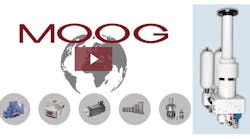Industrial hydraulics technology is often called on for a wide variety of die-forming applications because of the huge forces and high speeds it can transmit while also providing precise control. But higher forces and speeds can take their toll on the dies themselves, which is why die cushions were developed.
Die cushions act as synchronized shock absorbers to help dissipate the high energy when dies slam together. However, traditional die cushions can be labor-intensive to install, maintain, and replace. To overcome these limitations, Moog Inc., East Aurora, N.Y., recently introduced a modular die cushion system to extend the life of deep-drawing dies, improve system reliability, and reduce commissioning time for manufacturers.
Moog`s new modular die cushion system includes a main hydraulic cylinder with integrated position measuring, accumulators, a hydraulic power unit, and several integrated hydraulic manifolds. The system features software libraries, and the control unit’s hardware components provide a compact, robust hydraulic system enabling highly dynamic control. The use of hydraulic manifolds reduces the amount of hose, tube, and fittings required, which reduces the number of potential leak points and provides more compact circuitry than traditional line-mounted components.
Moog’s design team integrated the manifold flange of the new system directly to the cylinder, where it is connected to the main hydraulic accumulators by a separate adaptor manifold. The system reduces force overshoots, which can cause damage in a press. The modular die cushion system uses user-specific force profiles to ensure the highest level of accuracy in the drawing process.
“Customers will benefit from our extensive experience in developing motion control technology for presses,” explains Sascha Dany, hydraulic systems engineer at Moog Luxembourg. “The modular die cushion system’s software enables a longer life for deep-drawing dies, higher system reliability, and reduced time required for commissioning the system in a plant.”
Maintenance professionals can easily access the system because of the convenient mounting of its main components. The system offers flexible layout options for integrating the manifold and requires comparatively little piping, which helps user lower maintenance and piping costs.
Applications that can most benefit from the modular die cushion system include:
• wire-, tube-, sheet-, and swing-bending machines
• plastic presses
• deep-drawing presses
• forging machines and presses
• scrap and paper recycling presses
For more information, click here.


